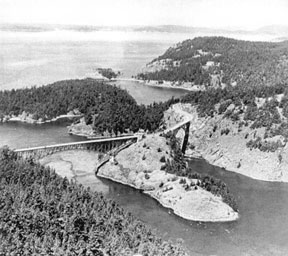One of the more interesting chapters in the Island’s history — even for people here on South Whidbey — is the construction of the Deception Pass Bridge, the only non-water link between Whidbey and the mainland.
That story is told in a recently published volume by noted historian and writer Dorothy Neil, a Whidbey Island resident since 1926. In “A Bridge Over Troubled Waters — The Legend of Deception Pass,” Neil describes how the Deception Pass Bridge came to be, the starts and stops for over 15 years and its ultimate construction in 1935 by the Civil Conservation Corps, in the midst of the Depression. The book even includes engineering drawings of this 900-foot-long span, 180 feet above what one Seattle writer called “the wickedest channel in Puget Sound.”
The book is now in a second edition, and publisher Joel Douglas, also the proprietor of the Coachman Inn in Oak Harbor, has given the South Whidbey Historical Society the publication rights to the 2002 limited edition of the book. It is now being sold as a fund-raiser for the society.
Douglas approached Neil in 1999 and inquired about her interest in writing the story of the famous landmark. According to the book’s foreword, Neil, then 89 years old, responded without hesitation, “I’d love to,” and had the first chapter on paper within hours.
The story — or series of stories — is populated by English sea captains, Indian guards for turn-of-the-century rum runners, early residents, and Berte Olson — the nation’s first woman ferryboat captain — who ran a pre-bridge ferry between Fidalgo and Whidbey islands and mightily opposed the bridge for many years.
The bridge’s birth is described from the perspectives of the various residents, with vignettes about the lives and struggles that took place as people came to terms with whether, and then how, the bridge would be built.
Neil also recounts intriguing tales, such as the state prison’s rock quarry on the pass side of Fidalgo Island, or the monster sightings in those turbulent waters.
The book presents historical photos from over the years and incorporates information gleaned through recorded history, interviews and written publications.
One of the chapters details South Whidbey’s sentiments about bridges — the one at Deception Pass and the one that has been proposed at various times for the Southend.
Neil cites one South Whidbey Record column by Jim Larsen about Whidbey Island bridges: “A South Whidbey bridge makes a good topic for rainy day discussions, but today nobody seriously proposes that one be built…It would link the small communities of Clinton, Langley and Freeland directly to such giants as Everett, Lynnwood, Seattle, etc. The Southend’s rural laid-back lifestyle would quickly become a thing of the past when subjected to hordes of people just a few minutes away by car.”
Neil says Larsen’s column quotes longtime Clinton resident Elsie Olkonen, who said, “There has never been support on South Whidbey for a bridge. We didn’t want that many people moving to Whidbey.” And he concludes that “South Whidbey residents are happy with only one bridge — and that is the one at Deception Pass.”
This limited edition of “A Bridge Over Troubled Waters” is available for $18 at various locations: Moonraker Books and the Historical Museum in Langley, Ace Hardware and BookBay in Freeland, and the Whidbey Island Museum and Kingfisher Books in Coupeville. All profits from the sale will support the South Whidbey Historical Society.
“The Deception Pass Bridge and Park are one of the most popular tourist destinations in the state of Washington,” said Charlis Dunham, a society board member. “Most of us who live here select it as a ‘must-see’ item for our visitors. Now we can have the facts about it at our fingertips. There are many famous bridges; more historic, higher and longer, but Deception Pass Bridge is known to be in one of the most beautiful settings in the world.”
Island Living editor Joan Soltys contributed to this story



